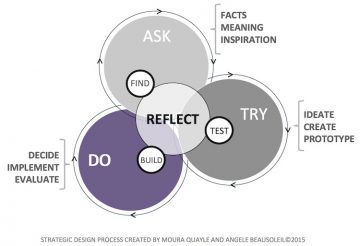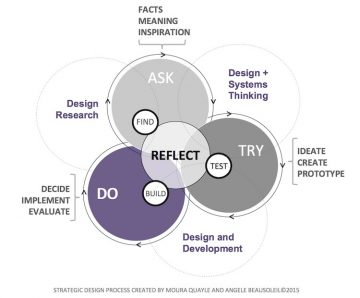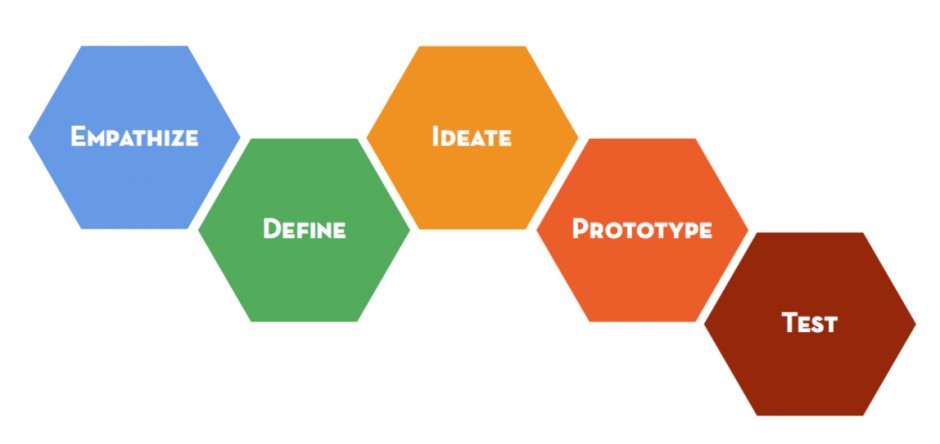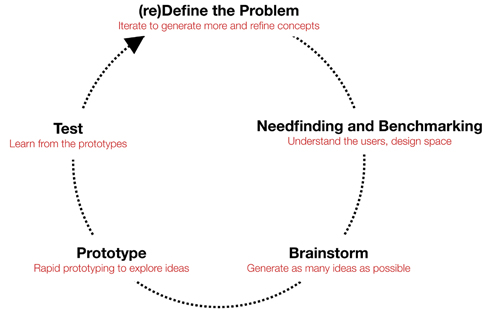UBC’s Strategic Design Method (SDM)

UBC’s very own design process, referred to as the Strategic Design Method (SDM) engages learners and participants in productive consultation, problem finding and problem solving. SDM is concerned with the articulation and integration of both internally-oriented individual and organizational practices (communication and knowledge production) and externally-oriented practices (societal value, market needs recognition and competitive positioning). SDM is designed, taught and practiced at UBC’s Sauder School of Business and Liu Institute. It offers a suite of design techniques and tools that constantly undergo adjustments and revisions to meet real-world client objectives. It is a structure that not only supports thinking and doing, but what to think about and how to “do” or act. SDM is about problem identification (asking why), problem setting (trying and testing) and problem solving (doing and evaluating). Its role is primarily to open and explore new issues before trying to understand how to solve them, using only available resources (Quayle, 2014). Described as a studio-learning method, the SDM at UBC was originally conceived by landscape architect and professor Moura Quayle and evolved in collaboration with PhD candidate Angèle Beausoleil.

IDEO Human-Centred Design (HCD) Design Process

The IDEO Human-Centred Design (HCD) toolkit is a process and a set of techniques used to create new solutions for the world. Solutions include products, services, environments, organizations, and modes of interaction. The reason this process is called “human-centered” is because it starts off with the people IDEO are designing for. It was originally created specifically for non-governmental organizations and social enterprises that work with impoverished communities in Africa, Asia, and Latin America. The HCD process encompasses three phases: Hear, Create, and Do.
To begin the process, there are three HCD lenses: Desirability, Feasibility, and Viability. First, a range of what is Desirable needs to be identified. Examine the needs, dreams and behaviours of the people you want to affect with your solutions. Seek to listen and understand what they want. What do people desire? Next, each solution needs to be viewed through the lenses of Feasibility and Viability. What is technically and organizationally feasible? What can be financially viable? These lenses are then carefully brought in during the later phases of the process.
The HCD Process
The HCD Process starts with a specific Design Challenge and goes through three main phases: Hear, Create, and Deliver.The process will move from concrete observations about people. During the Hear phase, stories and inspiration will be collected from people.To abstract thinking as insights and themes are uncovered. In the Create phase, teams will work together in a workshop format to translate what was heard from people into frameworks, opportunities, solutions, and prototypes.Then back to the concrete with tangible solutions. The Deliver phase will begin to realize solutions through rapid revenue and cost modeling, capability assessment, and implementation planning.
The Double-Diamond Design Process Model
 The Double Diamond diagram was developed at the Design Council (UK) in 2005 as a simple graphical way of describing the design process. Divided into four distinct phases, Discover, Define, Develop, and Deliver, the diagram maps the divergent and convergent stages of the design process, showing the different modes of thinking that designers use.
The Double Diamond diagram was developed at the Design Council (UK) in 2005 as a simple graphical way of describing the design process. Divided into four distinct phases, Discover, Define, Develop, and Deliver, the diagram maps the divergent and convergent stages of the design process, showing the different modes of thinking that designers use.
Discover: The first quarter of the Double Diamond model marks the start of the project. This begins with an initial idea or inspiration, often sourced from a discovery phase in which user needs are identified. These include:
- Market research.
- User research.
- Managing information.
- Design research groups.
Define: The second quarter of the Double Diamond model represents the definition stage, in which interpretation and alignment of these needs to business objectives is achieved. Key activities during the Define stage are:
- Project development.
- Project management.
- Project sign-off.
Develop: The third quarter marks a period of development where design-led solutions are developed, iterated, and tested within the company. Key activities and objectives during the Develop stage are:
- Multi-disciplinary working.
- Visual management.
- Development methods.
- Testing.
Deliver: The final quarter of the Double Diamond model represents the delivery stage, where the resulting product or service is finalized and launched in the relevant market. The key activities and objectives during this stage are:
- Final testing, approval and launch.
- Targets, evaluation and feedback loops.
d.school’s (Hasso Plattner Institute of Design at Stanford) User-Centered Prototype-Driven Design Process
The d.school’s Design Process is about using a human-centered approach to create innovative solution(s) to a problem.

It is a five-step design process – Empathize, Define, Ideate, Prototype and Test – that focuses on developing a d-studio ‘mindset’:
- Show, Don’t tell
- Focus on Human Values
- Craft Clarity
- Embrace Experimentation
- Be Mindful of Process
- Bias toward Action
- Radical Collaboration.
The Design Process is taught to graduates, K-12 students and design thinking bootcamps led by the d.school.
- Empathy: The centerpiece to a human-centered design process. People should provide the inspiration and direction for ideas. Responding to human needs allows one to create designs that are both useful and meaningful to people.
- Define: Synthesize information and distill it down to big takeaways. Focus on a specific user or user group: their needs and the insights discovered. Create an actionable problem statement to unify the team, inspire others, and provides a launching pad for ideating solutions.
- Ideate: Step beyond obvious solutions. Ideate to create fluency (volume) and flexibility (variety) in innovation options. Be prolific, wild, and visual!
- Prototype: Explore options, test ideas, gain empathy, or communicate vision. If a picture is worth a thousand words, a prototype is worth a thousand pictures.
- Test: Learn what aspects of the solution are resonating with users and which are not. This feedback helps guide subsequent iterations.
For methods on how to perform each step, go to the Design Thinking Bootcamp for more information.
UK Design Council’s User-Centred Approach
“Transformation Design” is a new design discipline that applies design skills to social and economic issues. It fosters interdisciplinary collaboration, proposes practical questions, and adopts a ‘user-centred approach.’ Fundamentally, it aims to show how design can help to create fundamental changes and social transformations.
The UK Design Council’s User-Centred Approach is a three-pronged method:
- Looking from the point of view of the user: Understand the world of the user of products and services, and see things from their perspective. This can help to generate insights into how things could change and it can thus form the basis of collaborative action.
- Making things visible: Making sense of complex information through the use of visual frameworks, can create a common platform for discussing alternatives, and make sense of opportunities and resources.
- Prototyping: Trying solutions out and getting feedback in situ and with the users to test out possibilities for creating transformative changes.
Stanford Design Innovation Process
 The Stanford Design Innovation Process is applied in ME310, a project-based design-engineering course at Stanford University. It is a course where students must design a complete system while being mindful of not only the primary function but also the usability, desirability, and societal implications. Throughout one academic year, student teams prototype and test many design concepts and in the end create a full proof-of-concept system that demonstrates their ideas.
The Stanford Design Innovation Process is applied in ME310, a project-based design-engineering course at Stanford University. It is a course where students must design a complete system while being mindful of not only the primary function but also the usability, desirability, and societal implications. Throughout one academic year, student teams prototype and test many design concepts and in the end create a full proof-of-concept system that demonstrates their ideas.
The design process in ME310 is cyclical. By going through the process multiple times, not only does it maximize student learning, it maximizes project insights for the student teams. “Fail early and fail often so you can succeed faster,” is one of the mantra for ME310.
To learn, apply, and experience the ‘Stanford Design Innovation Process’, student teams:
- Observe and interview users to better understand their needs.
- Benchmark existing technologies and products to identify the design opportunities.
- Extensively brainstorm to discover the obvious, crazy, and novel ideas.
- Iteratively prototype to quickly test their ideas and get a better understanding of their designs.
The end result is a refined design concept backed with key insights.
Design Thinking Innovation Process
The Design Thinking Innovation Process is a design thinking process taught in the “Design Thinker” workshop – an award-winning workshop built in collaboration with Experience Point , the leader in business simulations, and innovation design firm, IDEO.
It is an energizing workshop that challenges teams to flex their creativity to solve a realistic and complex design challenge. In so doing, they engage with the terms, techniques, and thought patterns of successful innovators. The participants navigate the design thinking process to originate innovative, workable solutions to a simulation problem.
Inspire: The problem or opportunity that motivates the search for solution
Ideate: The process of generating ideas
Implement: The path that lends form the project room to the market
Design Thinker helps business professionals
- See the opportunities for innovation around them
- Connect deeply with internal and external customers
- Transform insights and data into actionable ideas
- Create and implement new solutions with business impact, faster and more effectively.
In summary, Design Thinker readies participants to effect meaningful change back on-the-job.